本日の為替レート
Exchange Rate USD: 土, 27 7月.
バターン死の行進(Bataan Death March)
歴史を知ろう!

真正面から見たObelisk(オベリスク)
Death March Monument
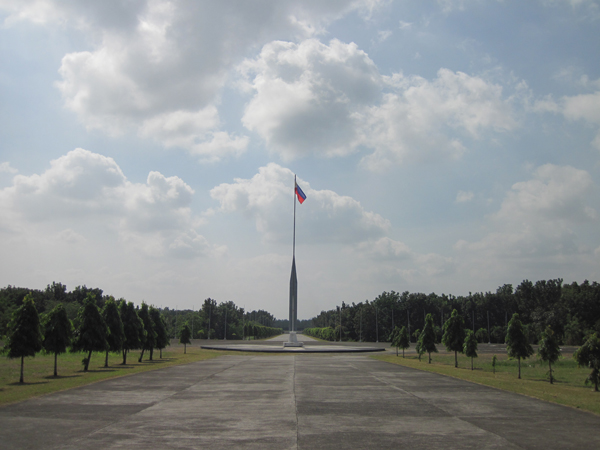
APSE留学中には歴史を学ぶ機会があります。フィリピンへ留学に来たのですからフィリピンと日本が過去にどのような関係性だったかなど知ってみるのはどうでしょうか?
[mappress mapid=”2″]
ここで紹介するバターン死の行進の終点地点ターラック州カパスに作られた遺産「カパス・ナショナル・シュライン(Capas National Shrine)」はAPSEから車で少し行った場所にあります。
カパス・ナショナル・シュライン(Capas National Shrine)

バターン死の行進・デスマーチ
(Bataan Death March)とは?
第二次世界大戦時、日本軍はフィリピン進攻作戦によって、1942年(昭和17年)4月9日にアメリカ軍のエドワード・P・キング将軍(Edward Postell King Jr.)が降伏しルソン島中西部のバターン半島を占領しました。そして日本軍に降参したアメリカ軍・フィリピン軍の捕虜にまともな食料や水も与えず、1942年5月1日頃まで、3週間近くもかけオドネル収容所(Camp O’Donnell)のあるターラック州カパスまで行軍させたのです。
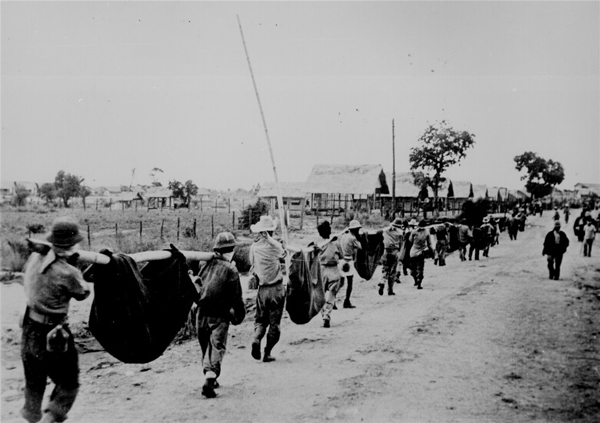
Wikipediaより引用
100km以上もある捕虜収容所への移動はトラック(アメリカ軍から奪ったものも含む)や鉄道、半分の道のりは徒歩によるものでした。さらに道中には日本兵による卑劣な暴行や虐待があり、炎天下の中マラリアや赤痢などの疫病が蔓延し多数の方が命を落としました。これが第二次大戦史上最も衝撃的な戦争犯罪の一つバターン死の行進(Bataan Death March)です。
収容所までの道のり


Wikipediaより引用
バターン半島を日本軍が占領した時にはフィリピン人約6万人、アメリカ人約9千人が捕虜として捉えられたとされていますが、最終的に収容所に移動できたのは約5万で、約2万~3万もの人がマラリヤ等の病気、飢えや疲労、そして日本軍の処刑によって命を落としています。
収容所に辿り着いた後もその劣悪な環境下での生活によって多くの命が奪われました。
※人数の詳細に関しては諸説ありますのであくまでも推定です。
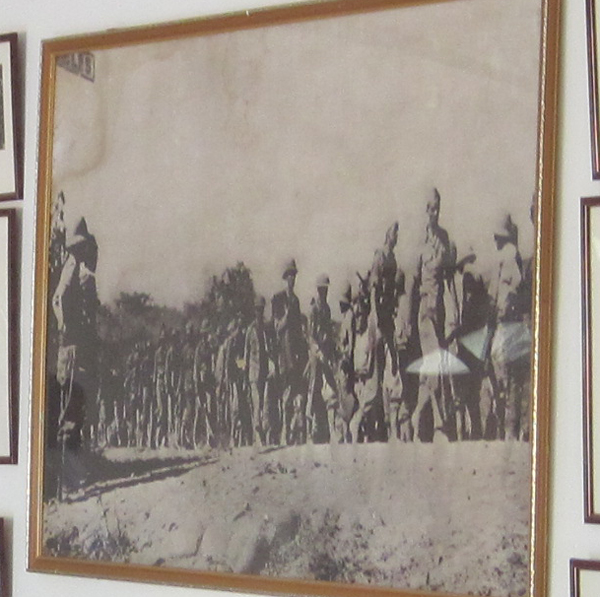
2009年からフィリピンではこのバターン半島の占領があった4月9日をフィリピン・アメリカの戦士を称える休日として勇者の日 と定めています。(勇者の日Day of Valor / Araw ng Kagitingan)
詳しくはフィリピンの祝祭日をご覧ください。
カパス・ナショナル・シュライン(Capas National Shrine)
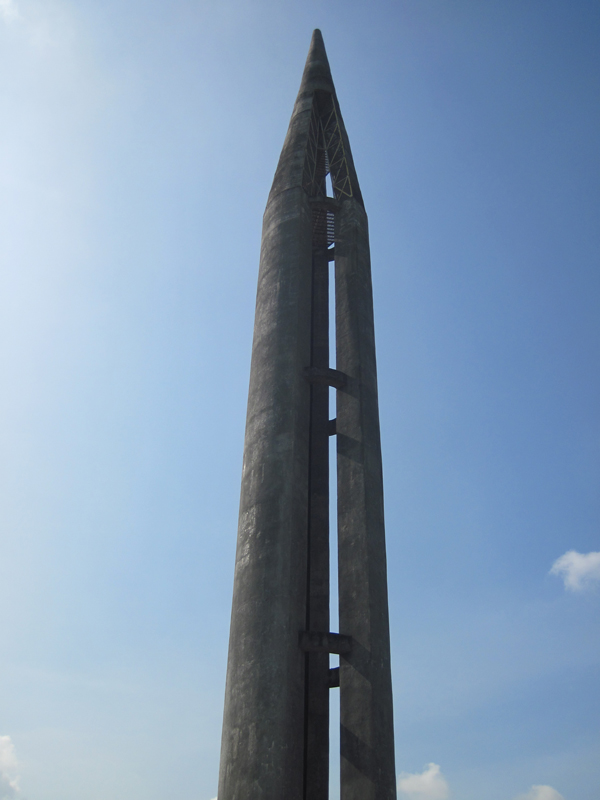
54ヘクタールの広大な敷地の中心に立つ高さ70メートルの塔(Obelisk)と塔を取り囲む黒い大理石の壁は3つのパーツで構成されていて、この3つのパーツはフィリピン人・アメリカ人そして日本人の現代においての平和への願いを象徴していると言われてます。
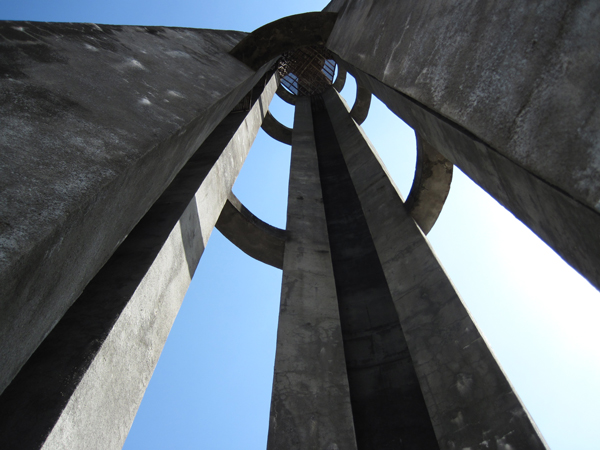
そして、この塔を取り囲む黒い大理石の壁にはバターン死の行進で命を落とした多くの人の名前と兵士の平和への願いを込めた詩が刻まれています。
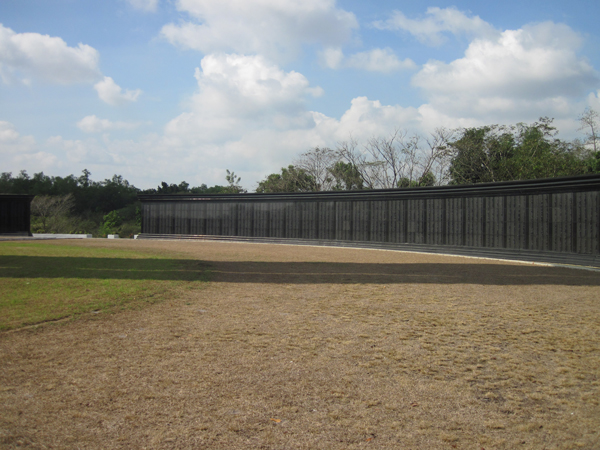
平和への願いを込めた詩

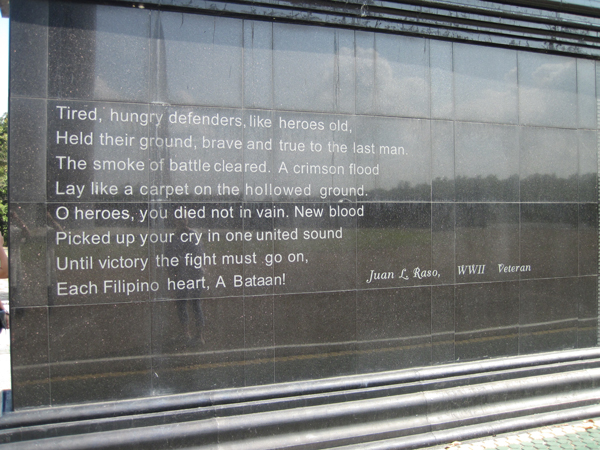
さらに、その周りにはバターンの死の行進によって尊い命を失った者たちに捧げられた木々たちが35ヘクタールにもおよび列を成し植えられてます。

この日はAPSEのオーナーの娘さん、Lorieにこの地をガイドしてもらいましたが、彼女の祖先の名もこの大理石の壁に刻まれていると話してくれました。彼女にこの地に連れて来てもらい初めてこのような歴史があることを知り、戦時中とは言え日本軍の非人道的な行為を聞かされた時には胸が苦しくなる想いでした。
フィリピンと日本にはこのような歴史がありますが、フィリピンの方々は私達日本人に対して常に明るく、そして親切に接してくれます。今の時代になり友好的な関係性が築けていることがとても幸せなことだと思える貴重な訪問でした。
CAPAS NATIONAL SHRINE
“Established as Camp O’Donnel in 1940 as cantonment center for the military training of the Filipino youth.
Became cantonnent and mobilization center of the 71th Division, PA, USAFFE on July 15, 1941, as ordered by the U.S.A. president ERANKLIN DELANO ROOSEVELT. Transformed into a Prisoner of War Camp by the Japanese Imperial forces after the “Fall of Bataan” and the surrender of the Filipino and American troops.
Renamed Capas Prisoners of War Concentration Camp. Around 60,500 Filipino and American prisoners of war were herded in this camp. Many became weak, sick and eventually passed away.
On July 25, 1942, approximately 30,000 Filipino and American prisoners died of sickness and malnutrition while under detention. Became Part of Clark Air Base Military Reservation after World War Ⅱ.
Turned over to the Philippine Government on the occassion the 40th Anniversary of Bataan Day on April 9, 1982.
Declared as capas National Shrine by Proclamation No. 842, dated December 7, 1991 by President CORAZON C. AQUINO.”
—原版より引用—
デス・ライド(Death Ride)
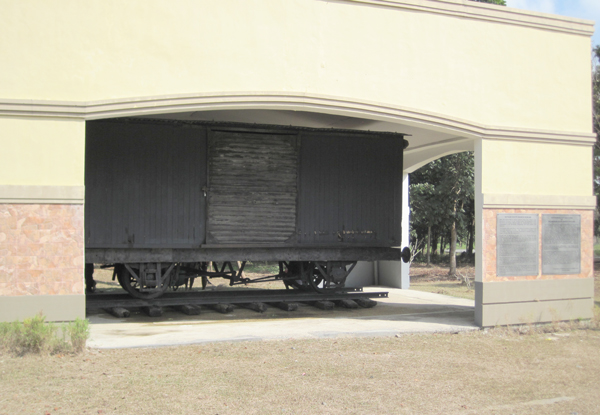
捕虜となったフィリピン軍、アメリカ軍はバターン半島のマリベレス(Mariveles)からサンフェルナンド(San Fernando, Pampanga)の区間約100km(65マイル)を歩かされ、その後、貨物列車に乗せられサンフェルナンドからカパス(Capas, Tarlac)まで道のり約48km(30マイル)を過酷な環境の中、移動を強いられた。これがデス・ライド(Death Ride)です。
護送に使われたBoxCar
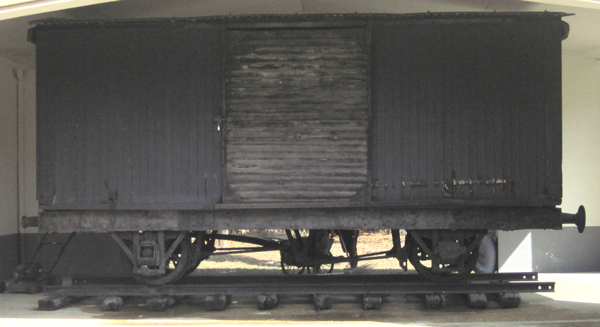
照りつける真夏の太陽の下を走る貨物車の中は灼熱と化し、換気口が列車のドアのわずかな隙間しか無い為、空気も薄く窒息寸前の状態の中、捕虜たちは座るスペースも無く立ったまま輸送された。
定員が50~60人の車両に150~160人の捕虜が乗せられている状態で、車内の温度はまるでオーブンのように上昇した、さらに赤痢が発症し捕虜たちは排便などのコントロールも出来なくなり、車両の床は尿や便、吐瀉物の海となった。横になるスペースさえ無い車内では立ったまま死んでしまった者も多くいたと語られている。
BATAAN DEATH MARCH BOXCAR
“After the Death March which claimed many lives, Filipino and American prisoners of war, having walked 105 kilometers from Mariveles and Bagac, Bataan under the intense April heat, were assembled in San Fernando, Pampangaand were loaded into boxcar.
This boxcar, and many like it, were used to transport Filipino and American prisoners of war – the defenders of Bataan and Corregidor – from San Fernando Pampanga to prison camps in Capas, Tarlac after the long march.
It was one of the many freight cars of the Manila Railroad Company before the World War Ⅱ .
Measuring about six feet long, eight feet wide and six feet high, this boxcar had wooden walls and metal roof. A larger version made of steel, was 33 feet long, seven feet high and eight feet wide.
At San Fernando, the prisoners were loaded into the boxcars by the Japanese guards who used their rifle butts and bayonets to squeeze more people than the capacity of the boxcars. Fifty to sixty men were forced into this particular type of car. As many as one hundred fifty to one hundred sixty men were crammed into the larger version of this boxcar. The boxcars so tightly packed that it became impossible to sit down.
The only source of ventilation and air was a tiny slit in the door of each boxcar.
The car, under the sweltering sun, rapidly became an oven, and men suffocated in the heat. Those afflicted with dysentery could not control their defecation and soon the floor of the car was filthy with excrement, urine and vomit. Many died where they stood in the boxcars.
This boxcar is the last known surviving freight car of its kind, and is a mute witness to the human sacrifice and heroism of all those who were victims of the Bataan Death March. It serves as memorial to the horrors of war and to man’s inhumanity to his fellow man.”
—原版より引用—
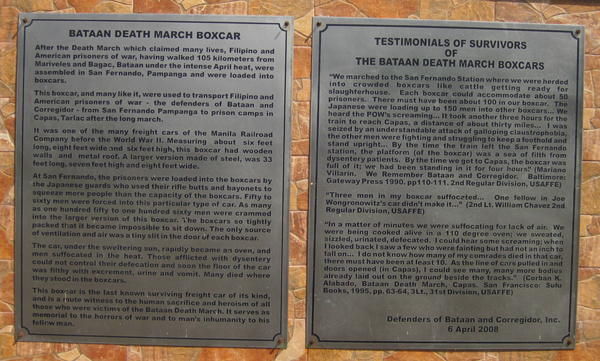
その後、数人のフィリピン人の友人に戦時中の歴史背景に関して聞いたところ、「歴史は歴史として受け止めてはいるけど、私たちは日本人に限らず海外の人が自分のたちの国に来てくれる時に嫌な想いはさせたくないから、常に家族を迎える時の様に居心地の良い環境を作りたいと考えている。」という心の内を話してくれました。
フィリピン人の寛容さに感動です。
ここ最近では、一部の中学高校の歴史の授業では若い世代が日本人に対し過大な憎しみを持たないようにと、第二次世界大戦中に起きたこの事件に関して全てを教えることはしない傾向になっているとも教えてくれました。
裏側から見たObelisk
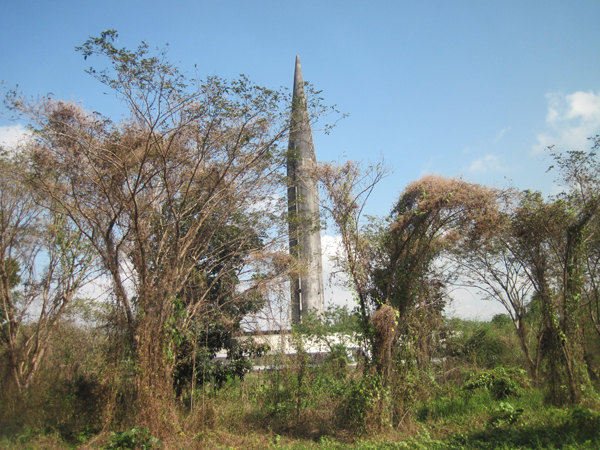
Tribute To A River
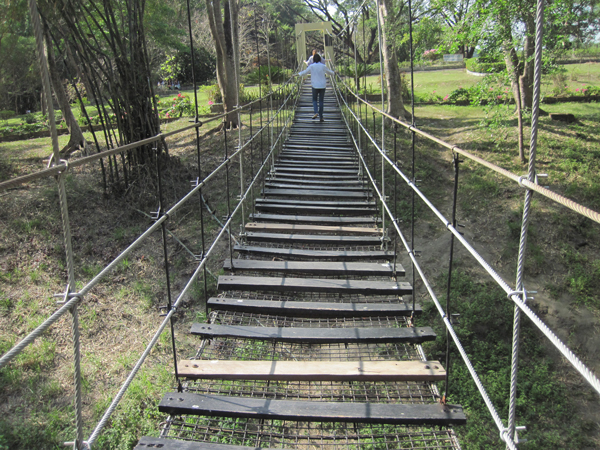
塔の裏側に回ると、つり橋があります。オドネル収容所(Camp O’Donnell)の近くを流れるオドネル川(O’Donnell River)は捕虜たちの命の源でした。オドネル川への賛辞と追悼の意を込めてつり橋は2001年4月に造られました。

下を見ると小川が流れてます。
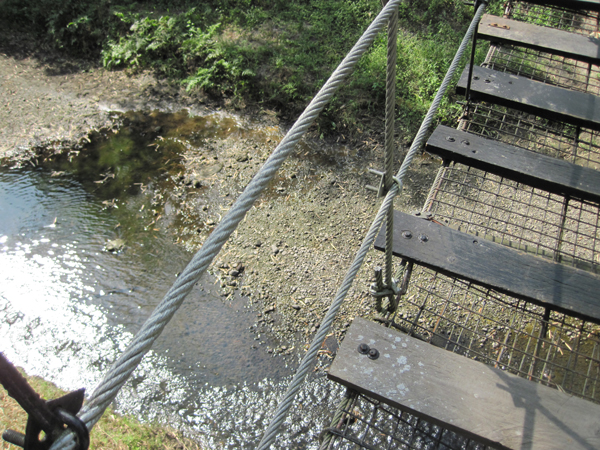
橋を渡るとそこは広場になっています、私達が訪れた時には恋人たちがベンチに座り寄り添い語り合ったり、学生さんたちが芝生の上に座って楽しそうにお弁当を食べたりしていました。そこには現代の平和がしっかりと存在しているのです。

広場には石造りのベンチがあり、そこにはたくさんのいたずら書きが・・・。きっと仲間同士で書いて笑っていたのでしょう。少々モラルには反することではありますが、戦争をして命を奪い合う行為に比べればいたずら書きくらいは微笑ましいことだなと、感じてしまいました。

DEFENDERS HALL

DEFENDERS HALLでは貴重な文献や当時の写真等を観ることができます。一つ一つを観ていくと当時の悲惨さや壮絶で過酷な状況が伝わってきます。

Hymn To The Defenders
兵士たちへの讃美歌
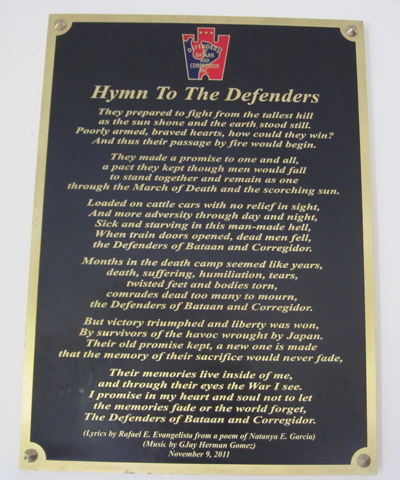
DEFENDERS HALLを後にして
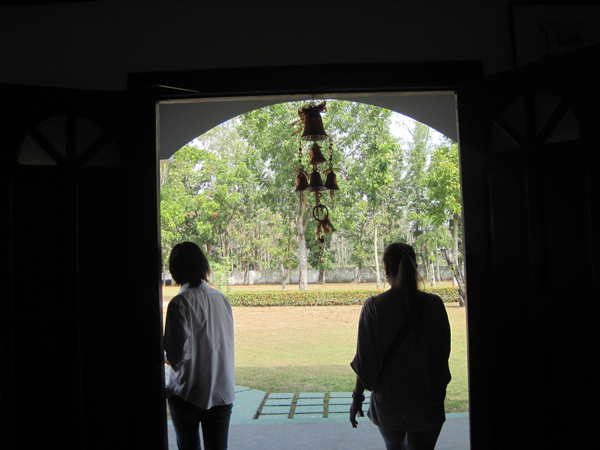
DEFENDERS HALLを出ると右手には死の行進によって命を落としたアメリカ兵のお墓があります。墓石にはびっしりと名前が刻まれてます。フィリピン人だけではなく多くのアメリカ人も犠牲になりました。もちろん多くの日本人もこの戦争によって命を落としてます。
アメリカ兵のお墓

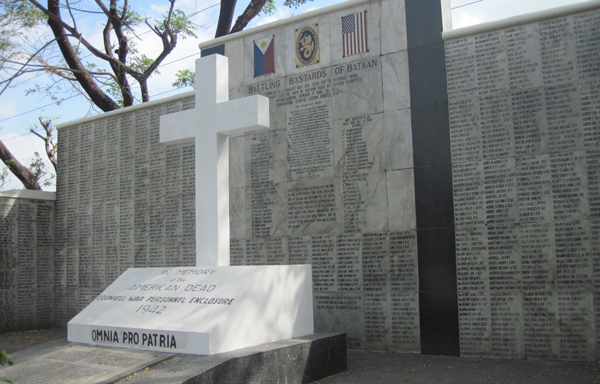
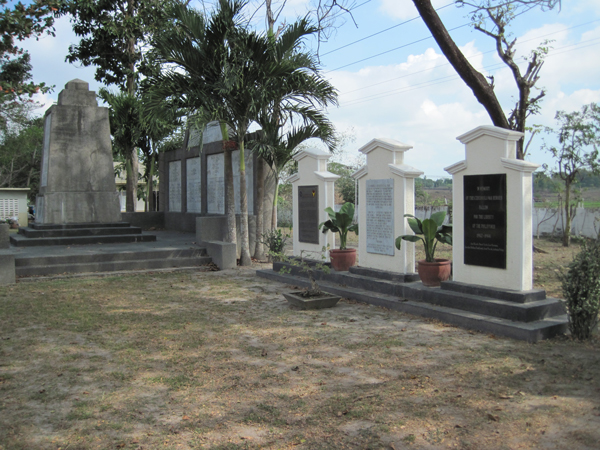
カパス・ナショナル・シュライン
(Capas National Shrine)

英語学習が目的のフィリピン留学ではありますが、フィリピンと日本の歴史を知ることも重要で意味のあることだと思います。APSEに留学に来た際に「カパス・ナショナル・シュライン(Capas National Shrine)を見学しに行きたい」と言ってもらえればスタッフがお連れ致しますのでお気軽にお申し付けください。
DESIGN FEATURES AND COMPONAENTS
“MEMORIAL MONUMENT
The “Obelisk” is the focal center of the entire shrine site which stands for peace.
The needle-like tower consist of three sections symbolizing the Filipino, American and Japanese people in this modern age of global peace, who have learned the lessons of war from the past.
Regulatory signal beacons is installed atop the obelisk, to symbolize the height of nationalistic aspiration of Filipinos towards peace and freedom.
The Mini-Forest (Nature Park)
to date, approximately 35 hectares of land hane been utilized for the reforestation of the shrine.
About 25,000 trees of various species(Mahogany, Duhat, Allbangbang, Mango, etc) have been planted.
The reforestation of the shrine area is a very appropriate action of the government so as to invoke invironment consciousness among the people in the province.
MEMORIAL PLAZA
A solemn gathering place to remember and honor the war heroes.
The large space provided allows the people to view the magnificence of the peace monument(Obelisk).
The scale and proportion of the site will create a monumental effect to excite the spectators imagination.
ESPLANADE
A wide mall along central axis from the front(main) gateway, to the Ceremonial Plaza, to the Flag pole and stretching to the Memorial Plaza and the Obelisk.
This central walk is flanked on both sides by mini-flagpole to accentuate the approach to the Obelisk.”
—原版より引用—



